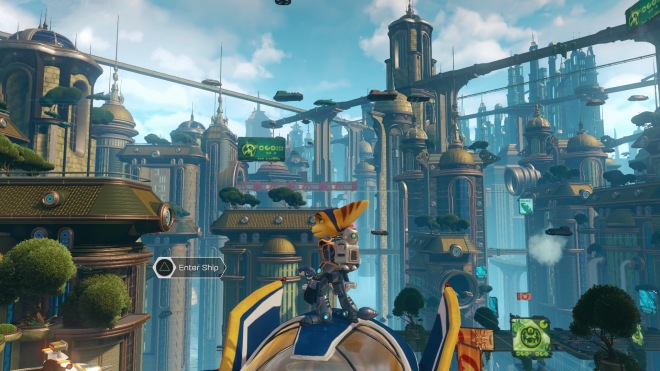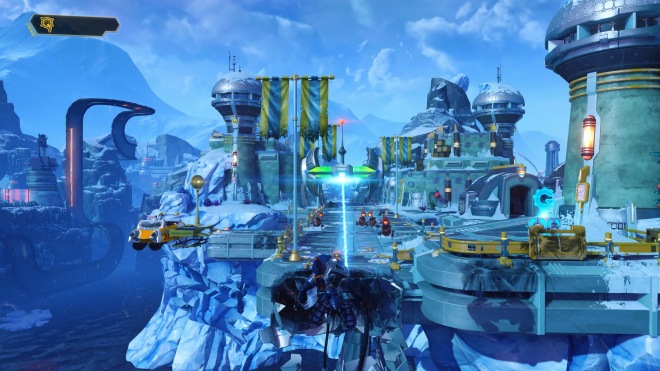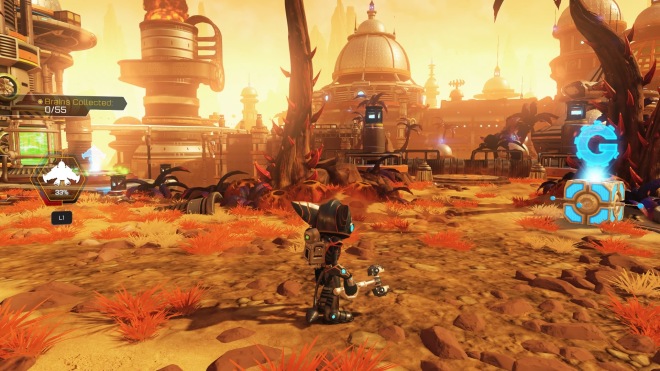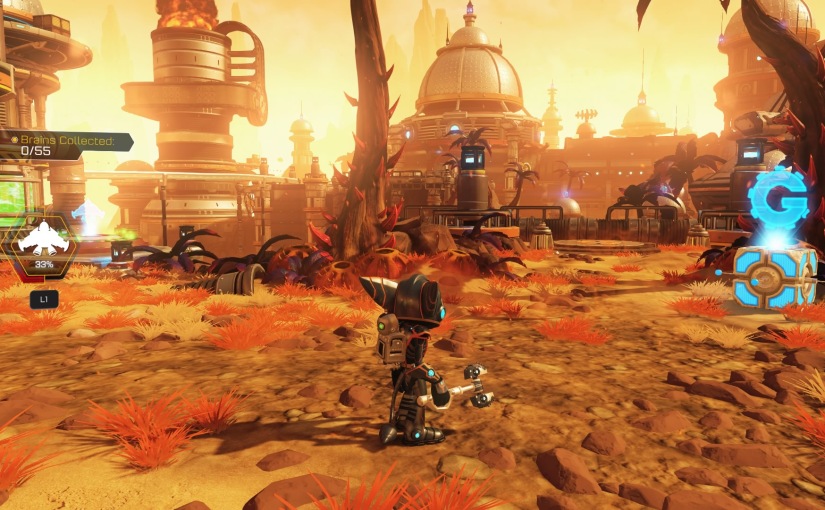Ratchet & Clank is likely to hold a nostalgic place in the hearts of anyone who owned a Playstation 2 back in the early 2000s. Its offbeat sense of humour, imaginative array of fantastic weapons and interesting gadgets cemented its place as a classic PlayStation series that arguably lost its way a little in the PS3 era. So, for its debut on the PS4, Ratchet & Clank heads back to its roots for a re-imagining of the first game.
That’s right, for a change of pace, this isn’t just an HD remake of the first game because they’ve already done that. Instead, this is a game based on the upcoming movie which takes inspiration from the original game. That somewhat confusing statement (that the game itself makes in the first few minutes) means that this is essentially a reboot. So while you’ll find yourself recognising locations and having a rough idea of where the plot’s going, until it ends in a completely different way to what you remember, it won’t entirely be a jaunt down memory lane.
That’s not to say you’ll be free of nostalgia once you jump back into the Solana galaxy. Being back on the beautiful water resort of Pokitaru or witnessing hover cars float through Metropolis (now called Aleero City) is sure to invoke fond memories of the original, except this time, these places actually look how your mind remembers them. Back in 2002 Ratchet & Clank was a great looking game for its time, but this re-imagining shows how far graphics have progressed in 14 years.
Whether it’s the volcanic planet Gaspar or Rilgar, a gloomy-looking planet with perpetual rainfall, the game looks incredible and is arguably the best-looking title on the PS4. For the most part, each new place feels distinctive thanks to a highly varied coloured palette keeping the visual treats interesting. There is a deliberate attempt to make each locale memorable and is most noticeable with the planet Batalia. Previously a fairly forgettable place, Batalia is now a cold, icy world where dogfights in the ongoing battle between Drek Industries and the Galactic Rangers take place above as you make your way through the level.
Who are these two groups? Well, the Galactic Rangers are an elite team of heroes who protect the galaxy. Whereas Drek Industries are an evil terraforming corporation that happily destroys or drains resources of other planets to build their own. The boss of this organisation is Chairmen Drek, a short alien known as a Blarg, whose head resembles a butternut squash. Drek is a great villain, and it’s good to see him back. The way he remains business-like while threatening to kill anyone who fails him, with all the nuance of a motivational speaker, is brilliant.
At the helm of the Galactic Rangers is the wonderfully obnoxious Captain Qwark. Long-time fans will be well aware of Qwark with his selfish nature and general idiocy. Despite evidence to the contrary, he’s a great character and is frequently the source of the funnier moments in the game. In this re-imagining, he starts the game in prison and then proceeds to narrate the events to a fellow inmate who wants to know how Qwark ended up in the slammer.

Having Qwark narrate the game is an excellent choice by Insomniac. His overly dramatic voice and disdain for Ratchet and Clank (who he hates for being more loved by the galaxy than he is) makes for some hilarious narration as the story unfolds. It pretty much plays out roughly how you’ll remember the first game up to a point. Dr Nefarious, a long-serving villain, wasn’t in the original game, but he appears here as Drek’s head scientist. This leads to further shenanigans that actually change the story you once knew quite considerably.
I can only assume Nefarious’ inclusion was down to Insomniac assuming that people don’t remember Drek all that well and wanted to provide them with a character that they would know, even if it’s not quite how you remember him. It doesn’t really hurt the story and, in fact, I like the changes the inclusion of Nefarious brings. However, the story is hampered a little by being a movie tie-in.
The game’s cutscenes are taken straight from the film, and whilst this means they look incredible, it also makes the story feel a tad disjointed. Moments after Ratchet and Clank have first met, the next cutscene shows them getting on like they’ve known each other for years. I can only assume that their development is covered in the film because it’s not shown here. Other than that, the story is an amusing jaunt, complete with the series’ signature humour providing a few chuckles along the way.
The story has never been the main draw of Ratchet & Clank though, the gameplay has. Somewhat obviously, I guess, this being a game and all. Anyway, it is fantastic. Wiping out an entire room of enemies and being rewarded by watching bolts (the game’s currency) bounce into Ratchet with an addictive tinkling sound is endlessly satisfying. The amount of methods of enemy removal at your disposal is also impressive.
The Ratchet & Clank series has a long history of creative weapons. So, instead of only including weapons from the first game verbatim, Insomniac have opted for a greatest hits of sorts. Weapons from each game are present with one new addition, the Pixelizer, which is essentially a shotgun with the bonus of turning the enemy into a pixelated version of itself. It packs a nice punch.
However, it doesn’t take anything away from the weapons in the game. The Groovinator is a disco ball grenade that makes every enemy in the game, including bosses dance like they just don’t care, giving you ample opportunity to kill them with something else. It’s a joy to see the wonderful amount of imagination put into each enemies dance – you’ve not truly lived until you see a tank bust out some sweet moves.

Every weapon in the game is also upgradeable, which can be achieved in two ways. Simply using the weapon to cause a ruckus will upgrade it, giving it more damage, and when you hit level 5, your gun will change quite noticeably. Mr Zurkon, a floating robot who loves killing folk, follows you around and fires at stuff automatically. It’s great for just having extra damage you don’t need to worry about dealing with. His limited lines will grate on you after the fifteenth time of hearing them, though. Anyway upon reaching level 5, he will gain an accomplice known as Zurkon Jr, doubling the damage output. More damage is usually what upgrades will result in, but the visual spectacle is also improved, making things on screen look crazier.
The Bouncer, a cluster grenade that bounces towards enemies like they’re magnets, will get to a point where firing one grenade will result in dozens of miniature explosions that can clear rooms in next to no time. It’s awesome to see, and the game’s performance doesn’t dip either, so you can gleefully unleash littles bombs of doom without worrying about the game chugging. The only downside is that the Bouncer is a pre-order bonus. Whilst I’ll probably talk about pre-order bonuses another time, I think in a game so strongly focused around its arsenal, it’s a bit of a dick move.
The second way to upgrade weapons is through raritanium. A material that can be collected by smashing crystals or just by killing enemies, you’ll get a fair bit of it without any real effort, so it doesn’t ever feel like a grind. You can then trade these crystals at a vendor to fill in an upgrade tree for each weapon. Taking the form of a hex-based grid this provides additional bonuses such as more bolts per kill or higher ammo capacity, none of which is particularly exciting, I admit. But it does make you feel like you’re always working towards something..
Additionally, each of these hex-based grids has many hexagons with question marks, and acquiring the space around these will unlock an additional upgrade that will add a new effect to your gun. This makes obtaining enough raritanium to unlock these upgrades a bit more exciting because you’ll wonder what new mod you’ll get for your weapons each time. This, coupled with the variety of your arsenal, alleviates some of the repetition that can come from endlessly killing folk.
The game also helps with this by making sure you’re not endlessly slaying enemies or at least changes the way you’re doing it. Though you spend most of the game controlling Ratchet, you’ll also have the opportunity to be his robot compadre Clank. These sections are less frantic and more puzzle focused. You’ll quickly acquire the ability to change little robots into three different forms – a bridge, a spring for reaching higher areas and one that is essentially a battery. These puzzles are pretty simple and usually involve getting all of these robots into one place so you can power up an objective. They are pretty satisfying to complete once, but on further playthroughs, they can become very tedious.
But at least they’re enjoyable the first time around, unlike the ship combat. The whole game feels well-polished apart from these sections. For something fairly small that can jet around without worrying about pedestrian things like gravity, Ratchet’s ship feels overly heavy to control. It looks like it should be fast and manoeuvrable, but it feels like trying to turn around a lorry. If you fly too close to a building while flying, you will sometimes take damage even if you’re not physically touching it and will sometimes get stuck and be forced to watch your health drop to zero as the ship shakes around like mad.

There are also Hoverboard races, which are mostly optional unless you want all the weapons, but they provide a nice break from all the shooting and have a good feeling of speed if you manage to hit all of the boost ramps. Similarly, there are also several grindrails dotted about the planets. These see Ratchet looping around the levels on a thin rail, and it feels like being on a rollercoaster. These sections are usually pretty straightforward and task you with jumping from one rail to another or knocking away mines, so it’s not too difficult. Regardless, these segments provide a great opportunity to admire the level as you hit heights that won’t achieve on planets that don’t allow you to use the jetpack.
Speaking of which, the jetpack is great. It adds verticality to the combat, allowing for aerial battles that are much more engaging than those you’ll have aboard the ship. They open the level up and give you a sense of freedom, even if this is only an illusion. There are also a few boss battles that allow you to use the jetpack and they are all really enjoyable. They allow the arenas where you fight the bosses to be much larger, giving the battles a grander sense of scale.
Once you’ve completed the game, you’ll be able to access challenge mode, which is basically new game plus. This will allow you to purchase the omega version of weapons so that you can level them up to 10, adding a bit of replay value to the game. You’ll only be able to do this if you’ve collected the three cards for a particular weapon, however. This isn’t as hard or boring as it sounds since you’ll gain cards by killing enemies and can trade in five duplicates for a card you don’t have yet. So you will get them all eventually.
The only cards you’ll have to hunt for are the RYNO cards. The RYNO is an overpowered weapon that makes an appearance in every Ratchet & Clank game, though how it works is often different. The cards are easy enough to find, and you’ll get two of them by beating both hoverboard races on gold, and it is well worth it. The RYNO is ludicrously overpowered and will drop a boss in no time at all. It is so much fun, even if it does take any challenge away from the game.
Considering the game doesn’t cost as much as a full release, I picked up my copy for £25 on launch, Ratchet & Clank is incredibly easy to recommend. It looks great, has stellar combat, and though sometimes unsuccessful, it makes an admirable attempt to mix things up so you‘re not just fighting enemies all of the time. It’s a wonderful introduction for newcomers to the franchise and long-term fans alike.
8/10
